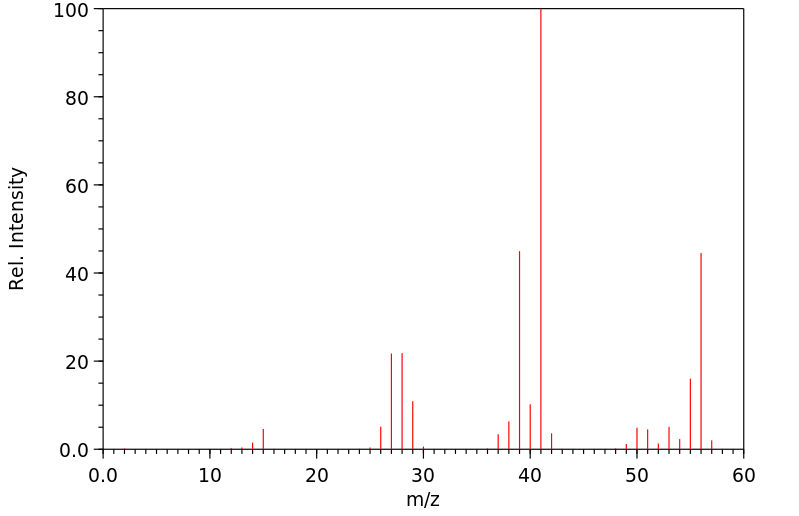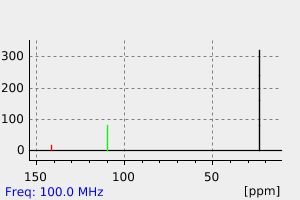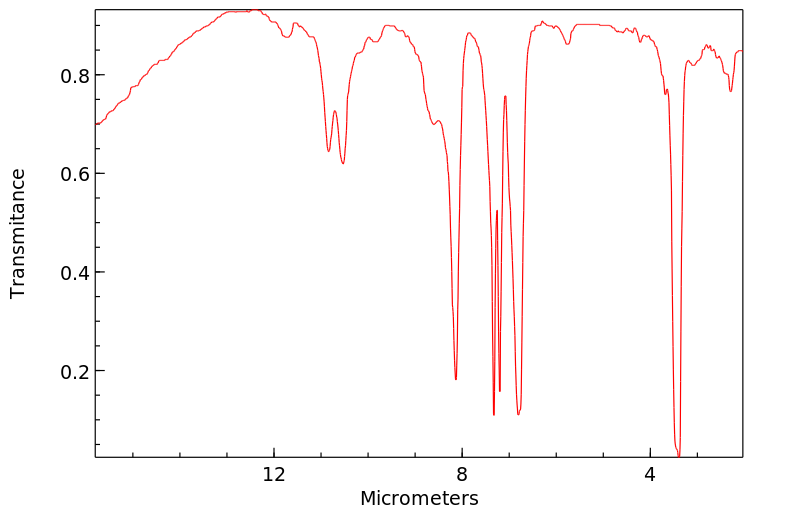异丁烯 | 115-11-7
-
物化性质
-
计算性质
-
ADMET
-
安全信息
-
SDS
-
制备方法与用途
-
上下游信息
-
文献信息
-
表征谱图
-
同类化合物
-
相关功能分类
-
相关结构分类
物化性质
-
熔点:−140 °C
-
沸点:−6.9 °C(lit.)
-
密度:0.5879
-
蒸气密度:2 (vs air)
-
闪点:-80 °C
-
LogP:2.35 at 20℃
-
物理描述:Isobutylene is a colorless gas with a faint petroleum-like odor. For transportation it may be stenched. It is shipped as a liquefied gas under its own vapor pressure. Contact with the liquid can cause frostbite. It is easily ignited. Its vapors are heavier than air and a flame can flash back to the source of leak very easily. The leak can either be a liquid or vapor leak. It can asphyxiate by the displacement of air. Under prolonged exposure to fire or heat the containers may rupture violently and rocket. It is used in the production of isooctane, a high octane aviation gasoline.
-
颜色/状态:Colorless gas
-
气味:Coal gas odor
-
溶解度:In water, 263 mg/L at 25 °C
-
蒸汽密度:1.9 (NTP, 1992) (Relative to Air)
-
蒸汽压力:2,308 mm Hg at 25 °C
-
亨利常数:Henry's Law constant = 0.218 atm cu-m/mol at 25 °C
-
大气OH速率常数:5.14e-11 cm3/molecule*sec
-
稳定性/保质期:
-
稳定性[28]:稳定。
-
禁配物[29]:强氧化剂、强酸、卤代烃、卤素。
-
应避免的条件[30]:受热。
-
聚合危害[31]:可能发生聚合。
-
-
自燃温度:869 °F (465 °C)
-
分解:Hazardous decomposition products formed under fire conditions: Carbon oxides
-
折光率:Index of refraction: 1.3926 at 25 °C
-
保留指数:384 ;392 ;391 ;391 ;390 ;390 ;380 ;390 ;385 ;370 ;384 ;390 ;383 ;384.2 ;384.9 ;387 ;388 ;388 ;386 ;383 ;390 ;400
计算性质
-
辛醇/水分配系数(LogP):2.1
-
重原子数:4
-
可旋转键数:0
-
环数:0.0
-
sp3杂化的碳原子比例:0.5
-
拓扑面积:0
-
氢给体数:0
-
氢受体数:0
ADMET
安全信息
-
危险等级:2.1
-
危险品标志:F+
-
安全说明:S16,S33,S9
-
危险类别码:R12
-
WGK Germany:-
-
海关编码:2901233000
-
危险品运输编号:UN 1055 2.1
-
危险类别:2.1
-
RTECS号:UD0890000
-
包装等级:O52
-
储存条件:储存注意事项: - 储存于阴凉、通风的易燃气体专用库房。 - 远离火种、热源,库温不宜超过30℃。 - 应与氧化剂分开存放,切忌混储。 - 使用防爆型照明和通风设施。 - 禁止使用易产生火花的机械设备和工具。 - 储区应备有泄漏应急处理设备。
SDS

| 第一部分:化学品名称 |
| 化学品中文名称: | |
| 化学品英文名称: | isobutylene |
| 中文名称 2 : | 2- 甲基丙烯 |
| 英文名称 2 : | 2-methyl propene |
| 技术说明书编码: | 101 |
| CAS No. : | |
| 分子式: | C 4 H 8 |
| 分子量: | 56.11 |
| 第二部分:成分 / 组成信息 |
|
| 第三部分:危险性概述 |
| 危险性类别: | |
| 侵入途径: | |
| 健康危害: | 主要作用是窒息、弱麻醉和弱刺激。急性中毒:出现粘膜刺激症状、嗜睡、血压稍升高,有时脉速。高浓度中毒可引起昏迷。慢性影响:长期接触异丁烯,工人有头痛、头晕、嗜睡或失眠、易兴奋、易疲倦、全身乏力、记忆力减退。有时有粘膜刺激症状。 |
| 环境危害: | 对环境有危害,对水体、土壤和大气可造成污染。 |
| 燃爆危险: | 本品易燃,具窒息性。 |
| 第四部分:急救措施 |
| 皮肤接触: | |
| 眼睛接触: | |
| 吸入: | 迅速脱离现场至空气新鲜处。保持呼吸道通畅。如呼吸困难,给输氧。如呼吸停止,立即进行人工呼吸。就医。 |
| 食入: |
| 第五部分:消防措施 |
| 危险特性: | 与空气混合能形成爆炸性混合物。遇热源和明火有燃烧爆炸的危险。受热可能发生剧烈的聚合反应。与氧化剂接触猛烈反应。气体比空气重,能在较低处扩散到相当远的地方,遇火源会着火回燃。 |
| 有害燃烧产物: | |
| 灭火方法: |
| 第六部分:泄漏应急处理 |
| 应急处理: |
| 第七部分:操作处置与储存 |
| 操作注意事项: | 密闭操作,全面通风。操作人员必须经过专门培训,严格遵守操作规程。建议操作人员穿防静电工作服。远离火种、热源,工作场所严禁吸烟。使用防爆型的通风系统和设备。防止气体泄漏到工作场所空气中。避免与氧化剂接触。在传送过程中,钢瓶和容器必须接地和跨接,防止产生静电。搬运时轻装轻卸,防止钢瓶及附件破损。配备相应品种和数量的消防器材及泄漏应急处理设备。 |
| 储存注意事项: | 储存于阴凉、通风的库房。远离火种、热源。库温不宜超过 30 ℃。应与氧化剂分开存放,切忌混储。采用防爆型照明、通风设施。禁止使用易产生火花的机械设备和工具。储区应备有泄漏应急处理设备。 |
| 第八部分:接触控制 / 个体防护 |
| 职业接触限值 | |
| 中国 MAC(mg/m3) : | 未制定标准 |
| 前苏联 MAC(mg/m3) : | 100 |
| TLVTN : | 未制定标准 |
| TLVWN : | 未制定标准 |
| 监测方法: | |
| 工程控制: | 生产过程密闭,全面通风。 |
| 呼吸系统防护: | 一般不需要特殊防护,高浓度接触时可佩戴自吸过滤式防毒面具(半面罩)。 |
| 眼睛防护: | 必要时,戴化学安全防护眼镜。 |
| 身体防护: | 穿防静电工作服。 |
| 手防护: | 戴一般作业防护手套。 |
| 其他防护: | 工作现场严禁吸烟。避免长期反复接触。进入罐、限制性空间或其它高浓度区作业,须有人监护。 |
| 第九部分:理化特性 |
| 主要成分: | 含量 : 一级≥ 99.5 % ; 二级≥ 98. %。 |
| 外观与性状: | 无色气体。 |
| pH : | |
| 熔点 ( ℃ ) : | -140.3 |
| 沸点 ( ℃ ) : | -6.9 |
| 0.67(-49 ℃ ) | |
| 相对蒸气密度 ( 空气 =1) : | 2.0 |
| 饱和蒸气压 (kPa) : | 131.52(0 ℃ ) |
| 燃烧热 (kJ/mol) : | 2705.3 |
| 临界温度 ( ℃ ) : | 144.8 |
| 临界压力 (MPa) : | 3.99 |
| 无资料 | |
| 闪点 ( ℃ ) : | -77 |
| 引燃温度 ( ℃ ) : | 465 |
| 爆炸上限 %(V/V) : | 1.8 |
| 爆炸下限 %(V/V) : | 8.8 |
| 溶解性: | 不溶于水,易溶于多数有机溶剂。 |
| 主要用途: | 用于制合成橡胶和有机化工原料。 |
| 其它理化性质: |
| 第十部分:稳定性和反应活性 |
| 稳定性: | |
| 禁配物: | 强氧化剂。 |
| 避免接触的条件: | 受热。 |
| 聚合危害: | |
| 分解产物: |
| 第十一部分:毒理学资料 |
| 急性毒性: | LD50 :无资料 LC50 : 620000mg/m3 , 4 小时 ( 大鼠吸入 ) |
| 亚急性和慢性毒性: | |
| 刺激性: | |
| 致敏性: | |
| 致突变性: | |
| 致畸性: | |
| 致癌性: |
| 第十二部分:生态学资料 |
| 第十三部分:废弃处置 |
| 废弃物性质: | |
| 废弃处置方法: | 处置前应参阅国家和地方有关法规。建议用焚烧法处置。 |
| 废弃注意事项: |
| 第十四部分:运输信息 |
| 危险货物编号: | 21020 |
| UN 编号: | 1055 |
| 包装标志: | |
| 包装类别: | O52 |
| 包装方法: | 钢质气瓶;安瓿瓶外普通木箱。 |
| 运输注意事项: |
| 第十五部分:法规信息 |
| 法规信息 |
| 第十六部分:其他信息 |
| 参考文献: | |
| 填表时间: | |
| 填表部门: | |
| 数据审核单位: | |
| 修改说明: | |
| 其他信息: | |
| MSDS 修改日期: | |
制备方法与用途
异丁烯又称为2-甲基丙烯,工业上主要通过炼厂气和裂解C4馏分获得。在炼厂气中,异丁烯的含量约为5%-12%,而在裂解C4馏分中的含量则为20%-30%。
应用异丁烯的应用可以分为两大类:混合C(已抽提丁二烯)馏分直接利用和高纯度异丁烯的加工利用。在农药工业中,主要用于制备有机磷杀虫剂特丁硫磷、拟除虫菊酯杀虫剂氯菊酯以及杀螨剂哒螨灵等;同时,它也广泛应用于轻工、炼油、医药、香料、建材及其他精细化工领域。
化学性质异丁烯为无色气体,熔点-140.35℃,沸点-6.8℃,折射率25℃下为1.381,相对密度在-49℃时为0.673,在气态时为1.998。它能与空气形成爆炸性混合物,爆炸极限为1.7%-9%(体积分数)。异丁烯可溶于有机溶剂,易发生聚合反应。
用途在工业上,高浓度的异丁烯主要用于生产聚异丁烯以及与异戊二烯共聚生成丁基橡胶。此外,异丁烯还可用于烷基化反应制备高辛烷值汽油添加剂甲基叔丁基醚(MTBE)。它也可作为芳烃烷基化原料,并通过氧化、氨化等操作生产精细化学品。其衍生物2-特丁基对甲酚与特定化合物偶合后可生成紫外线吸收剂,而邻-特丁基苯酚经硝化反应则可用于制备农用除草剂。
异丁烯还可以用于制备叔丁醇,通过氧化反应得到甲基丙烯醛和甲基丙烯酸,并通过氨氧化过程生产甲基丙烯腈。
生产方法在工业上,异丁烯通常由炼厂气或裂解C4馏分获得。其含量分别为5%-12% 和 20%-30%。少数情况下,可通过使用氧化铬-氧化铝催化剂催化异丁烷氢化制备。此外,在生产环氧丙烷时,通过共氧化法以丙烯和异丁烷为原料也能得到异丁烯的副产物。
目前主流的生产方法是甲基叔丁基醚(MTBE)的催化醚解反应。该过程涉及催化剂如Al₂O₃、硫酸盐、磷酸盐、铀的氧化物与氢氧化物及活性炭等,反应条件通常为150-300℃和0.3-0.6MPa的压力下进行,液体体积空速为1-5小时⁻¹。当使用改性Al₂O₃催化剂且温度设定在180℃时,回收率可达100%。
其他生产方法还包括从C₄馏分中通过硫酸或盐酸吸收、异丁烷脱氢、叔丁醇脱水、离子交换及吸附等技术来分离异丁烯。
安全与运输 类别有害气体
毒性分级低毒
急性毒性吸入-大鼠LC₅₀:620克/立方米/2小时;吸入-小鼠LC₅₀:415克/立方米/2小时
爆炸物危险特性与空气混合明火、受热可爆
可燃性危险特性明火、受热可燃;燃烧产生刺激烟雾
储运特性库房通风低温干燥;轻装轻卸;与氧气、空气等助燃气体钢瓶分开存放
灭火剂 职业标准STEL 100 毫克/立方米
上下游信息
-
上游原料
中文名称 英文名称 CAS号 化学式 分子量 2-甲基-2-丁烯 2-methyl-but-2-ene 513-35-9 C5H10 70.1344 丁烯 1-Butene 106-98-9 C4H8 56.1075 2-甲基-丁烯 2-Methyl-1-butene 563-46-2 C5H10 70.1344 2,3-二甲基-2-丁烯 2,3-Dimethyl-2-butene 563-79-1 C6H12 84.1613 天然橡胶 isoprene 78-79-5 C5H8 68.1185 亚甲基环丙烷 methylene cyclopropane 6142-73-0 C4H6 54.0916 3-甲基-1,2-丁二烯 Dimethylallene 598-25-4 C5H8 68.1185 三聚丙烯 propene 115-07-1 C3H6 42.0806 1-溴-2-甲基-1-丙烯 2-methyl-1-propenylbromide 3017-69-4 C4H7Br 135.004 1-氯-2-甲基-1-丙烯 1-Chloro-2-methylpropene 513-37-1 C4H7Cl 90.5526 -
下游产品
中文名称 英文名称 CAS号 化学式 分子量 2-甲基-2-丁烯 2-methyl-but-2-ene 513-35-9 C5H10 70.1344 丁烯 1-Butene 106-98-9 C4H8 56.1075 2-甲基-丁烯 2-Methyl-1-butene 563-46-2 C5H10 70.1344 天然橡胶 isoprene 78-79-5 C5H8 68.1185 2,3-二甲基-2-丁烯 2,3-Dimethyl-2-butene 563-79-1 C6H12 84.1613 三聚丙烯 propene 115-07-1 C3H6 42.0806 1-氯-2-甲基-1-丙烯 1-Chloro-2-methylpropene 513-37-1 C4H7Cl 90.5526 二甲基乙烯酮 dimethylketene 598-26-5 C4H6O 70.091
反应信息
-
作为反应物:参考文献:名称:Preparation of trialkylacetic acids, particularly of pivalic acid, using摘要:这项发明是一种从支链烯烃,特别是异丁烯,和一氧化碳中利用少量Lewis酸(如三氟化硼)催化生产三烷基乙酸,特别是偏戊酸的过程。公开号:US05227521A1
-
作为产物:参考文献:名称:一种溴甲烷制异丁烯的方法摘要:本发明公开一种溴甲烷制异丁烯的方法,包括如下内容:溴甲烷制异丁烯催化剂首先经过含水蒸气的混合气氛下低温处理,然后再经含氢气的混合气氛活化,活化后催化剂中溴含量为活化前催化剂中溴含量的30%‑80%,活化后的催化剂与卤代烷烃接触获得异丁烯,所述溴甲烷制异丁烯催化剂,按催化剂的重量含量计,氧化锌含量为0.5%‑20%,溴化锌含量为10%‑50%,载体含量40%‑90%,所述载体为氧化铝、氧化硅、ZSM‑5分子筛等中的一种或几种。该方法可以高选择性生成异丁烯。公开号:CN106146240B
-
作为试剂:描述:N-(t-butoxycarbonyl)-N-(4-methoxyphenyl)-2-methyl-3-phenyl-(E)-2-propen-1-amine 在 盐酸 、 sodium chlorite 、 sodium dihydrogenphosphate 、 benzotriazol-1-yloxyl-tris-(pyrrolidino)-phosphonium hexafluorophosphate 、 N,N-二异丙基乙胺 、 异丁烯 作用下, 以 二氯甲烷 、 氯仿 、 叔丁醇 为溶剂, 反应 51.0h, 生成 (2R,3S)-2-methyl-3,4-diphenyl-N-((1S)-1-phenylethyl)-butyramide参考文献:名称:取代的烯丙胺的不对称锂取代序列摘要:研究了2-和3-取代的N-(Boc)-N-(对甲氧基苯基)烯丙基胺与亲电试剂的(-)-斯巴丁胺介导的不对称锂取代序列。的非对称锂化-取代ñ - (BOC) - ñ - (p -甲氧基苯基)烯丙基胺类11,12,13,14,和15提供高度以良好的收率对映体富集enecarbamates。据报道可进一步转化为醛,酸,酮和Diels-Alder加合物。来自14和15的锂化烯丙基胺反应的1,4-加成产物具有共轭活化烯烃的15具有高的非对映异构体和对映体比率,以良好的产率得到具有两个和三个立体异构中心的烯氨基甲酸酯。这些产物通过酸水解和随后的环化反应进行合成转化,可以立体选择性地获得具有四个非对映选择性和对映选择性的四个和五个立体生成中心的双环化合物。建议通过不对称去质子化生成的烯丙基锂络合物与大多数亲电试剂反应,构型反转。DOI:10.1021/jo047752m
文献信息
-
MgI<sub>2</sub>-Mediated Chemoselective Cleavage of Protecting Groups: An Alternative to Conventional Deprotection Methodologies作者:Mathéo Berthet、Florian Davanier、Gilles Dujardin、Jean Martinez、Isabelle ParrotDOI:10.1002/chem.201501799日期:2015.7.27The scope of MgI2 as a valuable tool for quantitative and mild chemoselective cleavage of protecting groups is described here. This novel synthetic approach expands the use of protecting groups, widens the concept of orthogonality in synthetic processes, and offers a facile opportunity to release compounds from solid supports.在此描述了MgI 2作为定量和轻度化学选择性切割保护基的有价值工具的范围。这种新颖的合成方法扩大了保护基的使用范围,拓宽了合成过程中正交性的概念,并提供了从固体载体上释放化合物的简便机会。
-
[EN] INSECTICIDAL TRIAZINONE DERIVATIVES<br/>[FR] DÉRIVÉS DE TRIAZINONE INSECTICIDES申请人:SYNGENTA PARTICIPATIONS AG公开号:WO2013079350A1公开(公告)日:2013-06-06Compounds of the formula (I) or (I'), wherein the substituents are as defined in claim 1, are useful as pesticides.式(I)或(I')的化合物,其中取代基如权利要求1所定义的那样,可用作杀虫剂。
-
11-Deoxy-13-dihydro-prostaglandin-9-ketals
-
Novel 11-hydroxy-9-keto-5,6-cis-13,14-cis-prostadienoic acid derivatives申请人:American Cyanamid Company公开号:US04123456A1公开(公告)日:1978-10-31This disclosure describes certain 11-hydroxy and 11-deoxy-9-keto(or hydroxy)-prostanoic acid derivatives useful as bronchodilators, hypotensive agents, anti-ulcer agents, or as intermediates.
-
<i>Ex Situ</i> Generation of Stoichiometric and Substoichiometric <sup>12</sup>CO and <sup>13</sup>CO and Its Efficient Incorporation in Palladium Catalyzed Aminocarbonylations作者:Philippe Hermange、Anders T. Lindhardt、Rolf H. Taaning、Klaus Bjerglund、Daniel Lupp、Troels SkrydstrupDOI:10.1021/ja200818w日期:2011.4.20CO-precursor led to the development of a new solid, stable, and easy to handle source of CO for chemical transformations. The synthesis of this CO-precursor also provided an entry point for the late installment of an isotopically carbon-labeled acid chloride for the subsequent release of gaseous [(13)C]CO. In combination with studies aimed toward application of CO as the limiting reagent, this method provided使用简单的密封两室系统实现了异位生成一氧化碳 (CO) 及其在钯催化的羰基化反应中的有效结合的新技术。CO 的异位生成是通过钯催化的叔酰氯脱羰使用源自 Pd(dba)(2) 和 P(tBu)(3) 的催化剂产生的。使用新戊酰氯作为 CO 前体的初步研究为仅使用 1.5 当量的 CO 对 2-吡啶基甲苯磺酸酯衍生物进行氨基羰基化提供了另一种方法。 酰氯 CO 前体的进一步设计导致开发了一种新的固体、稳定、并且易于处理用于化学转化的 CO 源。这种 CO 前体的合成也为后期安装同位素碳标记的酰氯以随后释放气态 [(13)C]CO 提供了切入点。结合旨在应用 CO 作为限制剂的研究,该方法提供了高效的钯催化氨基羰基化,CO 结合率高达 96%。异位生成的 CO 和双室系统在几种药物化合物的合成中进行了测试,所有这些化合物都被标记为 [(13)C] 羰基对应物,基于限制 CO 的产率从良好到极好。
表征谱图
-
氢谱1HNMR
-
质谱MS
-
碳谱13CNMR
-
红外IR
-
拉曼Raman
-
峰位数据
-
峰位匹配
-
表征信息









